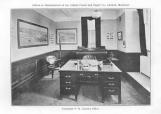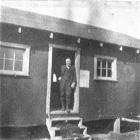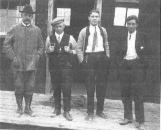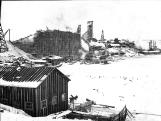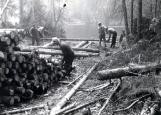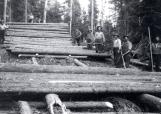2
The Early Life of Frank Harris Anson.Frank Harris Anson was born in Bellevue Michigan on October 26, 1859 during the American Civil War. His Parents were Austin Anson and Mae Harris. They moved soon after to Minneapolis. Attended a Niles public school and graduated from the University of Michigan. His Father was a "Cooper" who made barrels for the flour trade.
In 1882 F.H. Anson got a job with a railway survey party. A few years later he became a general passenger agent of the Minneapolis & St. Paul Railroad.
Next we find him in South America managing a track of land for the Orinoco Company and searching for rubber.
Returning to the States he joined a large flour exporting Company. He was sent on a selling trip to South Africa. He sold so much flour that the Company had to buy flour from Canada to fill the orders. One of these sources was the Ogilvie Flour Mills Company of Montreal. The Ogilvies were so impressed with that in 1900 they offered him a job. In 1903 he became General Superintendent.
The association with the Olgivies, established him as one the ablest business men in Montreal, respected by all. Montreal at that time was considered the commercial and financing capital of Canada.
Anson had one of the first cars in Montreal. Anson's' wife was the first woman to drive a car in Montreal. The cars were known as a "horseless carriage". That is what eventually led to the founding of Abitibi.
You see, Mrs. Anson used to take the car down to the blacksmiths for repairs. Two Montreal University students were working there for the summer and they persuaded Mrs. Anson to ask her husband to "stake" them for a summer to explore for gold up by the Porcupine Gold rush.
In the summer of 1909 the two students went north. They came back without any gold but reported on the boundless forest and fast flowing rivers. In the summer of 1910 Anson went North to see for himself. The he went to the Ontario Government to try and get timber rights. In the summer of 1911 Anson resigned from the Flour Mill because he decided that there was a future in a Paper Mill. The timber rights were slow in coming through. So in the meantime he went into the sugar refining business in Montreal with his long time friend R. L. Wilson.
September of 1912 Timber rights were granted so Anson resigned from the sugar milling business.
The timber rights that supply the Iroquois Falls Mill are under license from the Ontario Government. The first license was issued to Shirley Ogilvie and F.H. Anson in 1912 for an area of 1, 560 acres. As the Mill was expanded, over the years, the limit areas were increased to 4,252 square acres.
December 1912 the Company incorporated as Abitibi Power and Pulp Mill. December 9th, 1912 seven men left Montreal by train bound for the wild north where they were told a pulp and paper mill was to be built. These men had also heard of "Anson's Folly". One of these men was Kasper Lechnor. They reached the end of the steel and started out on foot by way of the Abitibi tributaries. They reached the chosen site on the Abitibi River on Christmas Eve 1912 and set up camp. First they built some tar paper shacks to live in, and cook house,
February 1913 they started clearing the site for the mill. They then began the construction period with no roads. Materials had to come down the tributaries and then down the Abitibi River by barge. Gradually progress was made. The construction equipment in those days was primitive but the workers were tough and strong. A whole Town had to be built. A power Plant, a coffer dam was thrown across the river to provide power. Suddenly tragedy struck. An unusual early spring break up smashed the coffer dam to pieces. Work was instantly started again, and this time the dam stayed. Anson was always there with his great personality and power of leadership. There was humor and good fellowship. Justice was rough and ready. One time the Superintendent caught a bootlegger who set up camp and sold bad liquor at the exorbitant prices. Caught in the act the superintendent had him suspended from a derrick and dunked in the river until he agreed to leave town.
In the meantime, Anson also had to raise some money. Some he got from Alexandra Smith, a business man in New York who went into partnership with Anson. Anson also went to Peabody Houghlelling & Co. for financing which he got on condition that the newsprint was to be added to the pulp mill.
In 1914 the Company incorporated as Abitibi Power and Paper Company and saw its first pulp produced in 1914 and the first paper produced in 1915.

